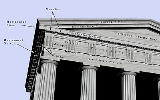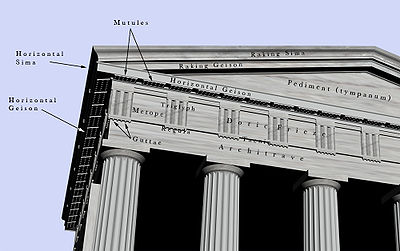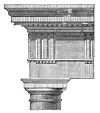
Gutta
Encyclopedia

Architrave
An architrave is the lintel or beam that rests on the capitals of the columns. It is an architectural element in Classical architecture.-Classical architecture:...
of the Doric order
Doric order
The Doric order was one of the three orders or organizational systems of ancient Greek or classical architecture; the other two canonical orders were the Ionic and the Corinthian.-History:...
in classical architecture
Classical architecture
Classical architecture is a mode of architecture employing vocabulary derived in part from the Greek and Roman architecture of classical antiquity, enriched by classicizing architectural practice in Europe since the Renaissance...
. At the top of the architrave blocks, a row of six guttae below the narrow projection of the taenia
Taenia (architecture)
Derived from the Ancient Greek tainia : "band" or "ribbon", taenia is the Latin word for a small "fillet" molding near the top of the architrave in a Doric column.In classical architecture, the entire structure above the columns is called the entablature...
(fillet) and cyma
Cyma
Cyma may refer to either:* A style of molding* Cyma Zarghami, the president of Nickelodeon and MTV Networks' Kids & Family Group* CYMA – Canadian Youth Mission to Armenia, a Canadian-run humanitarian program...
tium formed an element called a regula. A regula was aligned under each triglyph
Triglyph
Triglyph is an architectural term for the vertically channeled tablets of the Doric frieze, so called because of the angular channels in them, two perfect and one divided, the two chamfered angles or hemiglyphs being reckoned as one. The square recessed spaces between the triglyphs on a Doric...
of the Doric frieze. In addition, the underside of the projecting geison
Geison
Geison is an architectural term of relevance particularly to ancient Greek and Roman buildings, as well as archaeological publications of the same...
above the frieze had rectangular protrusions termed mutules that each had three rows of six guttae. These mutules were aligned above each triglyph and each metope. It is thought that the guttae were meant to represent the pegs used in the construction of the wooden structures that preceded the familiar Greek architecture in stone. Water drips over the edges, away from the edge of the building.


